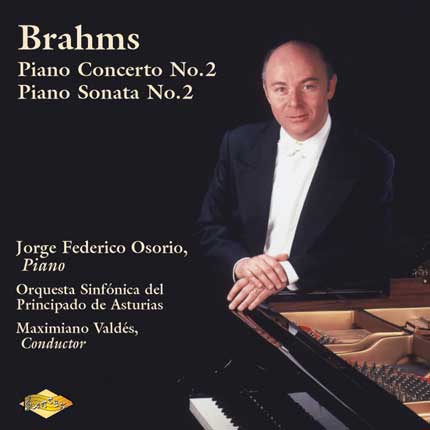ARTEK Recordings
Reviews of CD 14

Click to Order Recording

ARTEK Recordings |

|
![]()
ARTEK RECORDINGS CD14: Jorge Federico Osorio Brahms
Fanfare
The Mexican-born pianist Jorge Federico Osorio has made something of a specialty of Brahms, having recorded the concertos, the violin and piano sonatas (with Elmar Oliveira), and two CD's of solo piano music. His musical interests are not limited to Brahms only, however - his repertoire on CD covers a wide range, including music from the Classical and Romantic periods as well as Latin American and Spanish composers such as Ponce, Chavez, and Rodrigo.
Over a dozen years ago I reviewed Osorio's first Brahms solo piano disc and was impressed with his technique and musicianship. My favorable response is confirmed with this new disc: He brings to Brahms the requisite technical brilliance, energy, and firmly controlled rhythmic drive. Although he plays with the sweep and expression associated with the ".grand romantic" manner, he does not exaggerate phrasing or tempo changes; in fact, there is a good deal of restraint in his approach, with subtle nuances of expression. If I can find points of comparison in a general way, it is with the pianist Stephen Kovacevich, whose technical accomplishment and sensitivity endow his reading of the concerto with a feeling of complete, natural ease, and who also plays with restrained but expressive feeling.
The concerto is ably accompanied by the Chilean conductor Maximiano Valdes, whose career has taken him to conducting engagements around the world. His orchestra, based in Asturias, Spain, has a lovely sound, and the solo-playing - especially the memorable cello solo in the third movement - is on the highest level. The sonority of the piano, its balance with the orchestra, and the total ensemble, are all noteworthy.
The large-scale Second Piano Sonata is played with scrupulous fidelity to the score - but at the same time, Osorio's reading allows a large degree of personal interpretive nuances. In particular, he captures the Lisztian character of the first movement with its brilliant octave passages; in the second movement, he balances the inner voices beautifully. The feathery scherzo and its lilting trio are effectively played, and the Schumannesque finale - something in the style of a fantasy, with varied sections - comes to a brilliant climax. There is a lot of similarity in approach with that of Emanuel Ax. In fact, the timings of both pianists in each movement are almost identical (except for the slow movement, whose Andante con espressione marking is interpreted in a slightly faster tempo by Ax).
An additional attribute of this CD is the fine recorded sound - natural, sonorous, and beautifully balanced. The one unanswerable question here is why this exceptional pianist has not achieved (at least, in these parts) the renown he deserves.
This may seem an unlikely cast for a Brahms concerto--Mexican pianist, Spanish orchestra, Chilean conductor--but this performance is more satisfying than many with Germanic pedigree. Osorio's two previous recordings of Brahms's solo music were both excellent, and he is just as fine here. His playing has wonderful strength, and his rubato is always convincing. Occasionally, as at the end of II, he will push the tempo to good effect. Osorio has a great deal to say about and through this piece, and he has the technique to get it across. The orchestra from the Asturias region (far northern Spain) is a very fine group, and conductor Valdes is completely in step with Osorio. The sonics are very good.
The second sonata, published as Opus 2, is thought to antedate the first (Opus 1)
by a few months. If "wild and extravagant" are your criteria for
romanticism, you may find this the more romantic work. The sonata is full of
unexpected turns and impulses, usually expressed with virtuousity and in octaves.
Osorio captures the youthful impetuosity very well, urging the music along and
then pulling back with complete control. He compares favorably with a crisper,
virtuosic Rosel and a softer-grained Arrau. I can't imagine anyone going wrong
with this, particularly if the coupling makes sense for your collection.
- Althouse
![]()